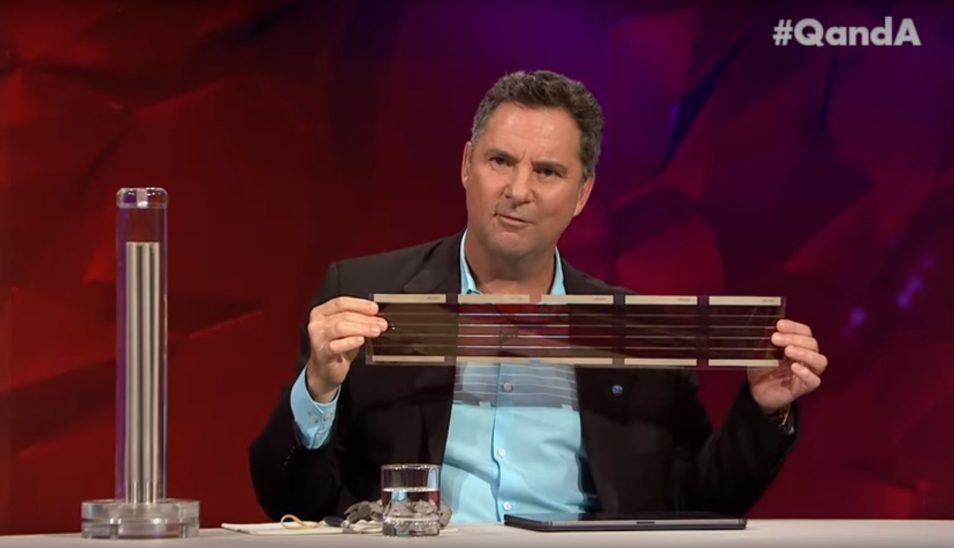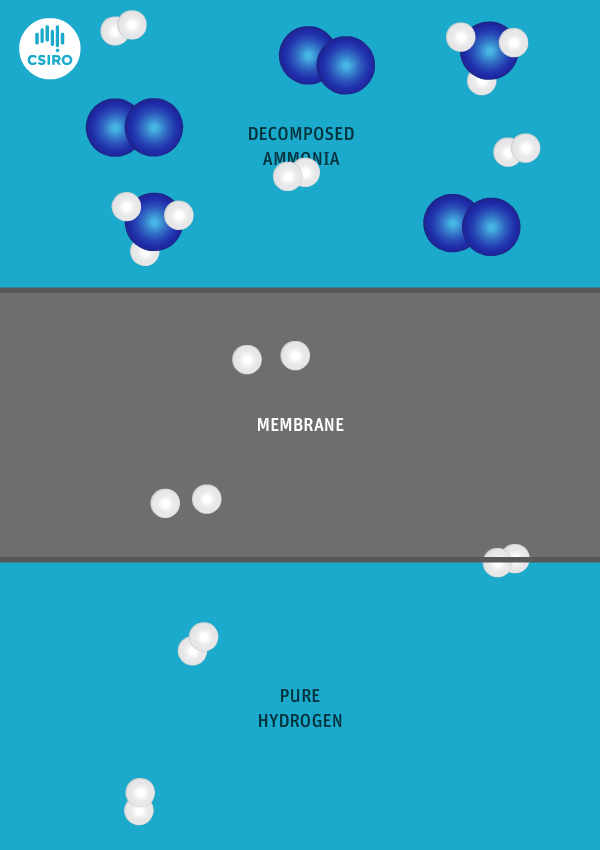
Larry with a flexible solar panel and hydrogen cracker, part of our plan for cleaner energy
Something kind of awesome happened last Monday. Did you catch it?
Our Chief Executive, Dr Larry Marshall appeared on Q&A for a special Vivid Sydney episode. And he didn’t disappoint. Naturally, we’ve had a lot of follow-up questions from our fans on some of the topics Larry spoke about.
So like Larry after smuggling all his gadgets into the ABC studios, let’s unpack some of the highlights! We’re going to show what these gadgets mean for the future of cleaner energy here in Australia.
Hydrogen: a cracker of an element
To request a transcript please contact us.
Some of you online called it a bong, others called it a prop from Mary Poppins. But this “thingy” is called a hydrogen cracker and it could be the key to unlocking our future in clean energy.
Our current energy exports consist of gas and coal, but there’s also an opportunity to export our clean energy. This includes solar. But it’s impossible to export solar energy unless you store and transport it in a fuel like hydrogen.
Hydrogen is a clean, abundant and highly adaptable element. But once we’ve produced the hydrogen, there are challenges in getting it to where it’s needed. Hydrogen has low density, making it very difficult to store and transport. Therefore it must be pressurised and carried by a pipeline, tanker or another secure method.
One idea is to use a ‘carrier’ fuel, like ammonia. Ammonia is a compound of nitrogen and hydrogen which is already used extensively in everyday household products (fertilisers, cleaners, etc). More importantly, it is way more stable than hydrogen.
But how do you get the hydrogen out again? Enter our hydrogen membrane! (also known as a hydrogen ‘cracker’). The membrane allows us to piggyback on existing infrastructure and transport hydrogen within the ammonia, to then extract it when we need it – like at a vehicle refuelling station.
“You can put a liquid fuel, ammonia, inside this and get pure hydrogen out the other side,” said Larry.
This has major ramifications for solving the problem of transporting hydrogen and other clean energy sources overseas for export.
The technology has been demonstrated successfully, powering two fuel cell vehicles with ultra-high purity hydrogen. This shows that there is scope for using it not only just in international exports but also domestically at your local petrol station.

Hydrogen can be extracted from ammonia, first by using a catalyst to help decompose the ammonia molecule into a mixture of nitrogen and hydrogen gas. Then, the hydrogen membrane allows hydrogen to pass through it while blocking any other gas.
The sun is shining on our printing parade
To request a transcript please contact us.
“So I’d like to do something a bit different – a home grown solar cell that we can produce here through…printing it rather than buying it from overseas,” said Larry.
Solar panels, or photovoltaic panels, convert sunlight to electricity that can power our constantly connected lives. But conventional silicon solar panels are not suited to all applications as they’re heavy, rigid and sometimes unsightly.
Our paper-thin printed solar cells (as seen in the video) are made from plastic and are flexible, lightweight and semi-transparent. This means they can be laminated onto windows and integrated into tents for either recreational or emergency relief purposes, to name just a few applications.
Let’s delve deeper into how the technology works and what this means for our future.
We use off-the-shelf equipment employing standard printing and coating techniques to make our flexible solar film. In some cases, we modify standard 3D printers to print our solar films. We can print a range sizes, from 1 cm wide all the way up to 30 cm wide. Our solar cells consist of five thin film layers over the top of each other – the thinnest is only around 20 nanometres thick! These thin film, flexible solar cells work in a similar way to conventional solar panels.
This technology can potentially be manufactured here in Australia, creating new opportunities for Australian manufacturing and value-adding to existing industries.
Show and tell on your screens
The gadgets Larry brought out on Q&A have so much potential for the future of clean energy here in Australia. We’ve done the heavy lifting where we’ve established the technology, so it’s ready for use right now.
We also have a wide range of projects in the pipeline which we’re hoping to implement in the near future. Take a look at the other ways we’re shaking up cleaner energy and finding more sustainable manufacturing practices.


18th June 2019 at 10:28 am
I saw the show, and I’m inspired by the level of expertise that Australian scientists, especially CSIRO, have available to forge our future.
18th June 2019 at 10:19 am
I saw part of the Q&A program and was excited by the possibility of linking some of these things to existing technologies.
Firstly the flexible solar panels. I was approached a couple of years ago by a German group working with an external manufacturer to produce flexible solar panels that could be readily incorporated with the flexible membrane liners that are used to cover water storages to control things like contamination and evaporation. Similar liners are used to cover waste water lagoons to harvest the gas. My understanding was that these panels roughly doubled the cost of the cover and this was not seen as providing sufficient benefit to be viable. Maybe the CSIRO printed panels will change this equation.
Now the hydrogen fuel derived from Ammonia with an in-vehicle converter. At present there are about 500 or more landfills around Australia with nitrogen and ammonia rich leachate stored in lagoons where there is little active treatment and a reliance on evaporation. On the rare occasions when we have put flexible membrane liner covers over these lagoons for odour control one of the issues was dealing with the ammonia. So in just about every city and town in Australia we have a ready made fuel source just waiting for us to tap in to it.
So I think there are some very real and current prospects there. If someone wants to contact me at sadlierma@gmail.com I would love to chat about it.
18th June 2019 at 9:11 am
Ammonia is NH3. The atomic weight of nitrogen is 14. The combined atomic weight of three hydrogens is 3. Molecular weight of ammonia is 17. So a cargo of hydrogen as ammonia will be 82% not cargo.
18th June 2019 at 9:01 am
Terrific work CSIRO, how can we get this technology operating asap ?
17th June 2019 at 8:46 pm
“Our paper-thin printed solar cells (as seen in the video) are made from plastic”…errmmm…I thought we were trying to REDUCE plastic in the environment? Minus one. I am not sure what future hydrogen as as a fuel. When we burn hydrogen, don’t we make water? Isn’t water vapour actually the most abundant greenhouse gas in the atmosphere? A quote from Wikipedia “Water vapor concentrations fluctuate regionally, but human activity does not directly affect water vapor concentrations except at local scales”. Surely though, if we globally start producing water vapour as a byproduct of energy production, it will mean that human activity will directly affect water vapour concentrations. Minus two. Has anyone actually run a simulation on the effect of large scale energy production (replacing fossil fuels with hydrogen) by burning hydrogen? In fairness, the Wikipedia article does go on to say that “The average residence time of a water molecule in the atmosphere is only about nine days, compared to years or centuries for other greenhouse gases such as CH4 and CO2. Thus, water vapor responds to and amplifies effects of the other greenhouse gases.”. However that is all based upon no (or minimal) human contribution to water vapour in the atmosphere. Burning hydrogen for energy surely changes all of that?